Zones for Single Laborers:
Skid Row and Chinatown
By the 1950s, most Americans had learned to use the pejorative term skid row for large areas of cheap lodging houses and their surroundings. But before the 1950s, these areas—with their high concentration of hotel housing—were very different places, for which the term single laborers' zone might be more appropriate. Even if polite citizens had rarely been to a skid row area, the names of those areas evoked vivid images. People often knew the area by the name of its major street: in
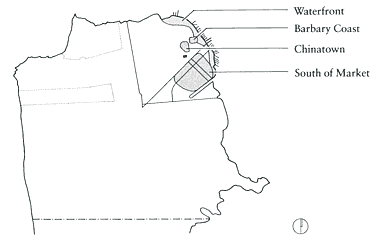
Figure 5.15
Single workers' neighborhoods in San Francisco. The small black
rectangle is Union Square. Streets indicated in the South
of Market are Third, Fourth, and Howard.
New York, the Bowery; in Minneapolis, Upper Hennepin Avenue; in Baltimore, Pratt Street; in Boston, Scollay Square; in Chicago, the Main Stem on West Madison Street; in Los Angeles, South Main Street.[51] Large cities typically had more than one single laborers' zone, and San Francisco had three: Third and Howard streets in the South of Market, the waterfront and Barbary Coast area, and Chinatown (fig. 5.15). Common characteristics of the people inhabiting these districts were unskilled and low-paid work, living outside of a private household of any sort, and being ostracized from the rest of the city. Differentiating the fates of the various districts were the survival of the jobs, the nature of activities mixed into the district, the degree of social ostracization, and competition for the land itself.
The Migrant Workers' South of Market
San Francisco's huge district south of Market Street had several neighborhoods within it, most of them packed with immigrant families living in tiny cottages and threeroom flats. Before World War II, the area was overwhelmingly white. In 1960, the population of the district was still over 75 percent white, with 14 percent black and 9 percent Asian. The South of Market flour mills, sawmills, refineries, printing plants, and machine shops generated large numbers of jobs for skilled workers and unskilled casual laborers.
Outsiders knew Third Street and Howard Street as the South of Market; these streets were the core of the casual workers' South of Market (fig. 5.16). Migrants often arrived in the railroad freight yards and walked north along Third Street. By the time they reached the corner
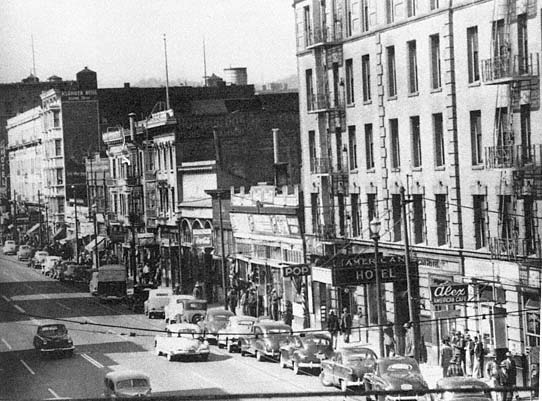
Figure 5.16
Third Street in San Francisco, 1953. Above the first floor virtually every building is a workers' hotel built
before 1920. Today, this is approximately the location of the Moscone Convention Center.
of Third and Howard they would have found all that they needed to be at home for the day, week, or month. A 1914 survey estimated that 40,000 single men lived in the South of Market at the peak of the winter, and half of the city's cheap lodging house rooms were in the district.[52] About a third of these men were permanent city residents.
By the turn of the century, Third and Howard streets were a typical single and migrant laborers' zone, a place that mixed cheap work, cheap rooms, cheap liquor, and cheap clothes. At its heart were multiple employment agencies in rented storefronts. Seven major employment offices competed next to each other on Howard Street between Third and Fourth, a very long block that is the site of the present-day Moscone Convention Center; other, similar agencies were located in the surrounding blocks.[53] Early in the day and in times of high employment, the agency clerks filled their shop windows and the interior walls with chalked placards listing jobs. At the beckoning of "800 HANDS TO COLUSA—SOUTHERN PACIFIC RR" or "40 SHOVELERS—4TH STREET," the men would be off to work for the day or the month. Outside the
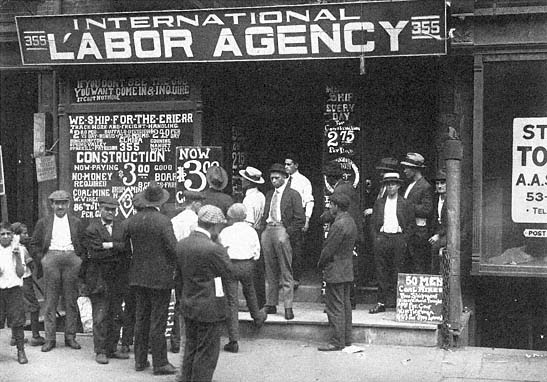
Figure 5.17
A labor agency on New York City's Lower West Side, 1910.
labor agencies men would stand and wait to register for work or for other listings to appear (fig. 5.17). In 1907, Nels Anderson and a friend stood on Omaha's great hobo employment center, Douglas Street, and estimated that they could see a thousand men on the streets and sidewalks. In slack times, the sidewalks outside the labor agencies were still the prime outdoor loitering and meeting spots of the workers' zone. People often loitered on the sidewalks throughout the year in such districts because there was no place to sit other than in a bar, card room, or other commercial establishment.[54]
Other prominent elements of the South of Market were working-men's saloons. Along Third, men found the greatest concentrations of workers' saloons, many with back room "bookie joints" that were legal until 1938. By 1910, San Francisco's saloons no longer served a free lunch, but they offered hearty 10-to 15-cent meals with the purchase of a glass of beer. Nearby were a distinctly grubby class of pool rooms and penny arcades. An occasional amusement hall, concert saloon with its cheerful and gladdening bathing beauties, and later, cheap movie theaters all added to the mix along the ground floors. Upstairs through
much of the zone would be the cheap rooms, cubicles, and dormitory spaces of the lodging houses.
Single laborers' zones also offered essential retail services for the workingman. San Francisco's South of Market had fifty-one second-hand clothing stores, twenty-one of them on the employment-office block of Howard Street alone. Retailers offering new clothing did not do so for "gents," as in the rooming house districts, but called themselves "outfitters": they sold serviceable boots, Levis, heavy shirts, and gloves for distant work camps. Trunk shops and storage locker businesses catered to men leaving town for a season. Radical bookstores supplied reading material aimed at a workers' revolution. A third of the city's pawn shops were also in the district, not far from charity missions and the Salvation Army "institute" or wood yard, which was on a side street. There were barber colleges offering free haircuts, medical and dental schools offering low-cost clinics. Men could also get dental work done on credit in the single workers' zone. In San Francisco, Greek migration was strong after 1910, and the local colony of Greeks began to run South of Market tea- and coffeehouses and inexpensive restaurants frequented by single men. In the evenings, some of the shops offered exotic dance shows. Houses of prostitution or assignation were never far away, but the single workers' zone in any city had fewer women and children visible on its streets than any other residential or commercial district of the city.
Bargain eating shops filled the interstices of the South of Market. Near cheap lodging houses workers always found the most reasonably priced food. A few large lodging houses had inexpensive eateries in them and offered American plan rates to their residents. Most lodging house tenants at the turn of the century, however, relied on saloon fare and the cheapest 5-cent to 15-cent lunchrooms available. For breakfast, San Francisco's Bolz Coffee Parlor promised "three of the largest doughnuts ever fried and the biggest cup of coffee in the world" for 10 cents. Coffee Dan's advertised "one thousand beans with bread, butter, and coffee" for 15 cents.[55] On a crash economy program, a man or a woman could eat three meager meals a day for as little as 30 cents in the mid-1920s. One elderly man gave this minimum-price daily menu:
Breakfast: "coffee and," 5 cents; sometimes with mush, 5 cents extra
Noon: hash, soup, bread, and coffee, 10 cents
Supper: stew, bread, and coffee, 15 cents[56]
At such rates, neither food nor service enticed the diners' palates. Over-worked waiters got plastered with food; stale bread and sour milk were common.[57] The cheapest meals were mission provisions given out free (fig. 5.18).
Life in the South of Market and other American migrant workers' areas began to change in the 1920s because of shifts in the demand for cheap work. As owners mechanized their factory, farm, mine, road-building, and lumber operations, they dramatically cut the need for casual migrant workers. The remaining migrants began to drive rickety automobiles to their work; in Kansas in 1926, for instance, over half the harvest workers came to the wheat fields by car. Having gradually lost the business of robust migrant workers who arrived by train, districts like the South of Market began to be identified more with the home guard.[58]
San Francisco had two other well-known single workers' areas. The Barbary Coast, although much tamed after its rebuilding from the 1906 fire, was still considered a disorderly district. It housed a great number of San Francisco's single sailors and longshoremen.[59] Inexpensive rooming houses and cheap lodging houses dominated the housing supply, mixed with various wholesalers' lofts, bawdy saloons, and houses of prostitution. San Francisco was the base for thousands of military men, and in their off-duty hours they often gravitated to the Barbary Coast (to the chagrin of their officers). After World War II, with the rapid decline of work for San Francisco's break-bulk water-front, the port workers were no longer needed; the recreational culture of the area was seen as an increasing threat. Not surprisingly, the Barbary Coast and waterfront areas were early targets of official and private redevelopment beginning in the 1950s. In the adjacent Chinatown, however, the neighborhood in 1990 stood much as it was rebuilt after the 1906 fire, and had similar uses.
Racial Rooming House Districts:
The Chinatown Example
The racial ghettos of many cities have had a high number of inexpensive hotel homes. San Francisco's Chinatown was somewhat unique, since the Chinese were imported as inexpensive laborers early in the city's history and were allowed, even after the fire, to remain in their downtown location—a three-block by seven-block Chinatown crammed with
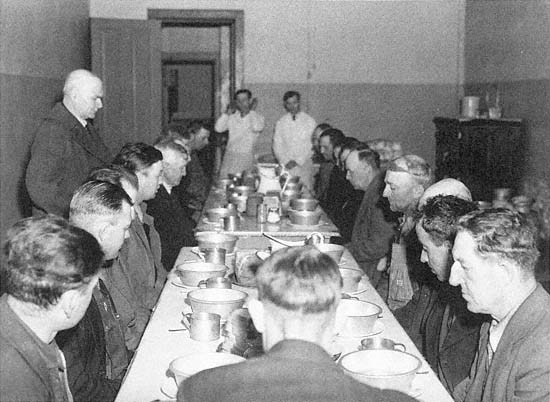
Figure 5.18
Compulsory prayer before dinner at a charitable mission, Dubuque, Iowa, 1940.
boardinghouses and lodging houses. In some ways, Chinatown was much like the Anglo South of Market. Chinatown had many privately owned cheap lodging houses and some better rooming houses; in 1980, half of the area's housing units were still in SROs. Chinatown's streets and basements were filled with affordable retail services and employment offices. There were counterparts to the missions, although Christian missions in Chinatown more vigorously took on acculturation as well as salvation. The population was largely male—but for a different reason. Until the 1960s, federal law forbade importation of wives and created a bachelor society in Chinatown. Wage conditions for the Chinese were even worse than those faced by American-born casual workers. Because of ghetto confinement, the Chinese neighborhood could not expand in spite of population pressures. Hence, the hotel housing conditions were worse. Whites, especially city officials and the police, saw Chinatown as a convenient place to dump (or not see) unsavory characters and illicit activities, even though this meant that gambling
houses, brothels, and drug dens were mixed with a law-abiding population of workers. As in other racial ghettos, a few local residents profited from the dumping process.[60]
Chinatown hotel buildings built after the 1906 earthquake, on their exterior, looked just like their counterparts in the South of Market or waterfront areas. The rooms and windows were similar sizes, often matching code minimums. Inside, however, the forces of economics, management, and ownership forced densities four times those assumed in the building standards. The Chinatown lodging house rooms were crowded with bunk beds. Men commonly slept in shifts, and tenants often did their own cooking in simple communal kitchens. To help each other ignore this appalling population density, Anglos used cultural stereotypes such as "the Chinese tolerate crowding better than white people." Whites (not aware that Chinese were rarely allowed to own property) also defended the densities by pointing to Chinese-managed family association buildings, which had similar densities on their living floors. The multiuse family association buildings functioned in part as subsidized lodging houses. On the ground floor would be commercial spaces leased to leading association members; on the second and third floors were crowded hotel rooms that housed bachelor members; on the top floor were offices, meeting rooms, or social halls for the entire association.[61]
San Francisco's Chinatown was neither monolithic nor completely Chinese. Almost immediately it became an important tourist zone and (on a square-footage basis) probably did far more profitable retail business than did the Howard Street businesses. White workers and non-Chinese Asians also lived in significant numbers on the edges of Chinatown. In the late 1800s, Mexican workers lived directly to the east. After 1900, Manilatown—a concentration of thirty-seven hotels housing up to 10,000 Filipino workers—straddled the border between the core of Chinatown and the Barbary Coast. The workers used the Lucky M Pool Hall as their informal information center. San Francisco's International Hotel, of 1977 eviction fame, was a workers' hotel of a fairly typical 184-room size built in 1907 (fig. 5.19). Twelve stores filled the ground floor, and billiard halls and a well-known nightclub were housed in its basement.[62] A block to the west, in 1939, the permanent residents of the border-location Clayton Hotel revealed the
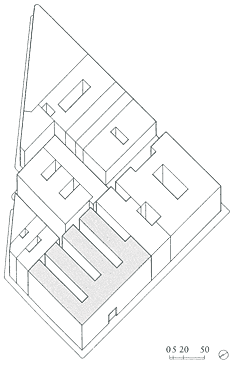
Figure 5.19
Axonometric view of the International Hotel
and surrounding buildings in Manilatown,
San Francisco. The 184-room hotel (shaded)
was built in 1907 with more generous light
wells and larger rooms than average.
In this block, most structures are hotels.
area's ethnic and racial mixture: 25 Filipino, 15 Chinese, and 22 white workers.
While most Chinese were segregated into Chinatowns, city authorities on the West Coast allowed Japanese immigrants to operate and live in rooming and lodging houses in several districts of the city, usually outside of Chinatown. Some white workers preferred Japanese-leased hotels because of their management style. In San Francisco's Western Addition, Japanese-managed hotels seem to have been racially mixed; in the South of Market, all-Japanese residents were more the rule.[63]
Until the 1930s, San Francisco had a very small black population. However, in other cities lodging house districts for blacks were similar to San Francisco's Chinatown. Like Chinatowns, black lodging house districts crowded workers (who were paid less than their white counterparts), suffered from double housing standards in city inspection and code enforcement, and endured a high proportion of unsavory uses dumped there by outsiders. The several-block area of cheap lodging houses in the middle of Chicago's Black Belt was a prime example. It served thousands of black workers who were hired by the railroads and meat packers, where blacks could get jobs earlier than they could in
most other industries (fig. 5.20). In 1990, it remained as one of the largest remaining SRO concentrations on the city's South Side.[64]
Another lodging house pattern, front-gate lodgings, served workers stranded at an eccentric industrial location. For large factories initially built beyond the edge of the city, speculators often built nearby clusters of rooming and lodging houses as well as family houses and flats. San Francisco's Union Iron Works, for instance, employed up to 5,000 men but was four miles from Third and Howard. The hour walk each way to and from the factory cut too much into the casual laborer's day. By 1900—with the factory owners actively encouraging the development—the workers could choose from over thirty commercial wooden rooming and lodging houses and almost as many saloons within three blocks of the factory gate (fig. 5.21).[65]
Rationales for Lodging House Life
For the men and women who lived in cheap lodging houses, the looming advantage was low price. But cheap lodging houses had other advantages. For the indigent elderly, the advantage of ambulatory independence in a central location was particularly prominent. (This was true of other ranks of hotel life as well.) As long as older tenants could walk, they could meet their own needs. California researchers found that elderly residents cherished their independence. Anderson described areas of a few blocks that satisfied all the employment and services needed by former hoboes. A great many of the aged men and women who lived their last years in cheap lodgings lived in grim surroundings. Yet the psychological benefits of maintaining their personal choice and self-reliance seemed to be the most important attractions of staying in hotel housing, just as it is for the elderly in hotel housing today.[66] For workers, cheap hotels and their staff also provided specific stabilizing services. Before 1925, in the heyday of the cheap lodging house districts, men could turn over their summer earnings to the hotel proprietor, who acted as banker and bursar. This ensured that the hobo or sailor would not lose all his money in one first spree.[67]
For the most outcast people—drifters, unemployables, thieves, or prostitutes—rooming houses simply offered a place to be. Technically, state laws required hotel managers to accept any reasonable person for one night, although managers did not have to accept everyone on a weekly or monthly basis. On occasion, however, landlords welcomed
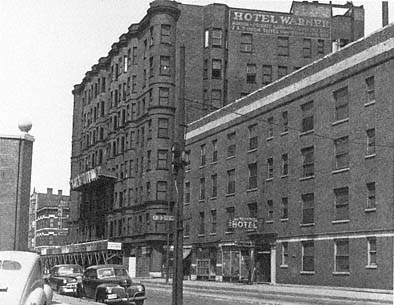
Figure 5.20
Hotels for black workers on Chicago's South Side. The Hotel Warner
and Memorial Hotel on Cottage Grove Street, photographed in 1950.
long-term tenants who were outcasts elsewhere. Poor casual laborers made up a reliable market for slumlords and honest landlords alike. By renting to hoboes, building owners with a warm heart or a dilapidated and unrentable loft space could invest very little money and yet reap a tidy profit. A madam could pay substantially higher leases than other tenants and pay additional sums under the table to the building owner, to district politicians, or to the police. The flophouse floor, even with its vermin, was still a viable commercial space.
The financial pressures on managers who leased cheap hotels probably did the most to open places for outcast people. Each month the lease had to be paid. Only rented rooms brought income. When rooms were going empty, or where the architectural or sanitary conditions were already at a low ebb, undesirable tenants were better than no tenants at all. Managers of "no-tell hotels" that allowed men to take women to their rooms found that they could charge a higher rent. Harvery Zorbaugh asked one hotel keeper how many married couples there were in her house. Her answer: "I don't know—I don't ask. I want to rent my rooms."[68] As long as couples paid, she did not oversee their moral life as old-fashioned boardinghouse keepers might have done. Such management realities, taken to their extreme, fostered the worst social and physical conditions of all types of inexpensive hotels.
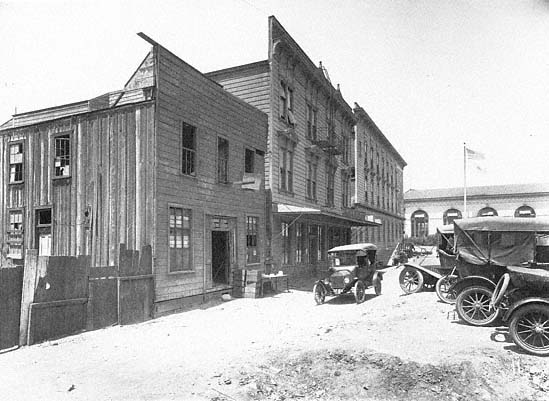
Figure 5.21
Line of wooden rooming houses near the Union Iron Works shipyards in San Francisco, photographed
just before demolition in 1918. The closest building was probably intended to be temporary.
For so-called homeless men, cheap hotels and the area around them were also more than shelter. They were a significant part of hobo identity, just as suburban houses became important for family identity in the middle and upper class. However, unlike suburban houses or better hotels, cheap lodgings were more important as a type of building than as individual structures. The way casual laborers relied on built space contrasted with the manner of the middle and upper class. Wealthy hotel dwellers lived in highly individualistic buildings; their hotel homes were part of an elaborate and individuated material culture system. Midpriced or palace hotel residents could further anchor their identities with their professions, marriage partners, personal pedigrees, and clothes or other possessions. Single laborers, who moved often and easily from one cheap lodging house to another, relied on a more generalized use of the city fabric. They lived largely within a nonmaterialistic and verbal subculture. The social organization and membership in the American day laborer's subculture relied less on unique possessions and more on story telling and social drinking. While less individu-
ally anchored to specific buildings, casual laborers were nonetheless identified with hotels as a group. The anthropologist James Spradley has maintained that flops (places to sleep) made up the most significant set of words in hobo language and culture; no other American group had so many words for places to sleep.[69] Other recent research suggests that, among no-family people, setting in large part can become life-style. The hotels, street corners, parks, and businesses of cheap lodging house districts—even though fluidly used and seen as virtually interchangeable—provided an essential and meaningful backdrop for the single laborers' individual and social worlds. Cheap lodging house districts socially countered the low esteem of hobo employment and provided an island in a hostile dominant society.[70]
Employers and bankers could see advantages to lodging house life, too. The individual freedom of people living completely apart from a family and without material possessions dovetailed precisely with the needs of employers for maximum flexibility and control over a set of workers. The single, more atomized residents of cheap hotels could adjust more easily than family-tied workers to the whimsy of economic demand for a risky new business or a sudden big contract.[71] At a more abstract level of capital circulation, commercial single-room housing had additional benefits for landowners and managers of the middle and upper class. When thousands of workers lived as part of a family or boarded with a family, that rent money went into the family sector; it went back into the control of the private urban community. Hotel life, however, channeled the workers' rent and food money directly into commercial circuits, retail hands, without passing through a private household. More than in family tenement districts, the money of hotel life went into commercial entertainment and commercial socializing. The architecture of the no-family house also displayed these uneasy truces between the renters, the owners, and the employers of the city.